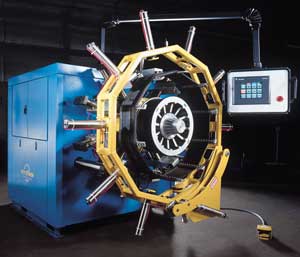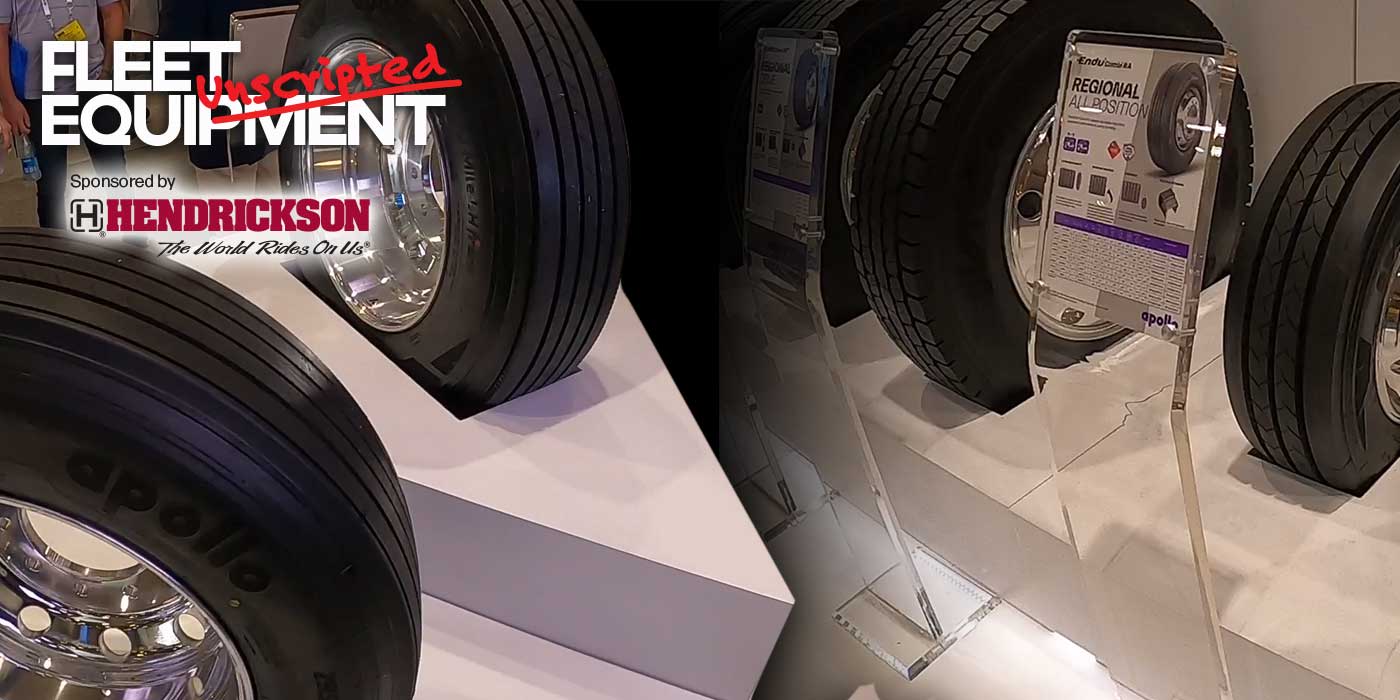Because tires are the third highest cost for trucking operations—behind wages and fuel—savvy fleets have long considered retreads as one way to improve their bottom lines. Modern retreads offer more technology and options than ever before, resulting in improved performance and added value for fleets.
![]()
“The quality of retreads has never been better, and maintenance managers recognize that the economic advantages of a well-managed tire program that includes retreading is essential to obtaining the lowest operating cost,” said Bill Sweatman, CEO of Marangoni Tread North America. “Technology used in the production of retread materials and in the manufacturing of the retreads themselves has steadily improved, so retread performance is comparable to that of a new tire.”
According to Jay Hofner, general retread manager for Goodyear Commercial Tire Systems, “Extending the life of a valuable asset through retreading yields quantifiable savings without sacrificing tire performance. Once first-time users experience the benefits of retreaded tires, they are sold on the concept. And in a challenging economy, our existing customers have done everything they can to get more life out of their truck tires through retreading.”
At a cost that is 30% to 50% less than new tires, today’s retreads are made from casings that are designed to provide multiple retreads and offer certain benefits—such as fuel efficiency—through each tire’s lifecycle, noted Bert Jones, product marketing manager for Bridgestone Commercial Solutions. Retreading accounts for half of all replacement tires and has for some time, he added as proof of their wide use and acceptance.
For fleets that have not already adopted retreading, successive price increases paired with supply shortages for new tires offer even more incentive, said Libor Heger, Continental Commercial Vehicle Tires’ brand manager for the Americas. “Many fleets also now understand that the retreading technology and processes today are not the same as those that may have dissatisfied them in the past, so they’re willing to give it another try.”
Environmental consciousness also is a factor that has led to greater acceptance, Heger added. “Fleets are being held to higher standards of carbon emissions reduction in order to provide competitive bids for business. Because it takes only a third the amount of oil to produce a retread vs. a new tire, using retreads has an immediate effect on a fleet’s carbon footprint.”
Marangoni’s Sweatman estimates that retreads save over 200 million gallons of oil annually.
However, not every retread is created equally, according to Ted Becker, vice president of marketing for Michelin Americas Truck Tires. Fleets must look for a reputable, trusted retread provider that uses the latest technology in both designing and building the retread, he said.
Selecting a retreader
There is much for a fleet to consider when it comes to sourcing retreads, from selecting the right supplier to choosing tread designs that match specific applications.
A successful new tire and retread program requires a closely-followed service program that includes such items as air pressure maintenance, vehicle alignment and proper tread design and load rating choices, Becker added. “Suppliers that offer fleets the ability to manage their casing assets and respect their product and service specifications provide a competitive advantage,” he said.

Goodyear’s Hofner advised there are three things a fleet should consider when selecting a retread supplier: the retread supplier should be able to serve the fleet’s entire operating area; it should be a total solutions provider that can give meaningful data about the fleet’s retread usage; and the supplier needs to be able to make meaningful recommendations based on the data collected.
“How this information is used us just as vital as the ability to collect it,” he said. “If a fleet’s solutions provider is not helping make better business decisions, then that fleet is probably leaving money on the table.”
Marangoni’s Sweatman noted fleets should establish clear expectations after looking at all the options available in order to achieve expected results. He also recommends taking a tour of the retreader’s facility to better understand its capabilities and to help in further developing a strong, mutually beneficial relationship.
On a related note, fleets should consider asking potential retread suppliers to come to their location and do a fleet inspection and scrap tire analysis, according to Michelin’s Becker, who added retreaders need to understand what fleets currently are doing, and more importantly, what they should be doing in the future.
“This could include their choice of new tires, their choice of retread products and their future needs for service,” he said. “Again, casing asset management and measuring performance are key factors to consider.”
When fleets select a supplier, they are choosing more than just someone to buy tires from. “They are also choosing someone to provide service,” said Bridgestone’s Jones. “Since retreaded tires go through another manufacturing process, there are items such as casing pickup and delivery to take into account. This can affect the way tires flow into and out of the system.
“The casings should be viewed as an asset similar to a truck,” he continued. “Before a fleet would send a truck off for repair, I’m sure it would check on the credentials of the service provider and the time it would take to fix. Casings should be viewed the same way.”
Establishing a best practices guide for retreading is an important step toward receiving the best service and value, recommends Continental’s Heger, who said, “Fleets should have a documented policy that ensures their retread suppliers are following industry recommended practices, as well as paying attention to the fleets’ preferences.
“Establishing and documenting retreading guidelines for the fleet, such as the number of allowable section repairs per quadrant, the maximum size of repairs and the maximum allowable repair cost, helps reduce confusion and ensures that only the casings deemed acceptable by the fleet are being retreaded,” he added.
Newer retread technology
The performance capabilities of retreads have only improved as technology has advanced. Today’s premium, steel-belted radial tires are meant to be retreaded—and as maintenance procedures have improved, so has the opportunity to get more use out of tires, Marangoni’s Sweatman said, adding that casing inspection, application-specific treads and spliceless precure tread technology all have improved retreading performance.
Retreads today also are produced in a variety of tread designs, tread widths, tread depths and rubber compounds to provide the best performance characteristics to meet specific application needs, Michelin’s Becker added. “Fleets should utilize their suppliers’ expertise in choosing what products to run on their trucks,” he said.
Another step forward in retread design has been improvements in inspection technology, according to Bridgestone’s Jones, who said, “New technologies have been developed that can inspect a tire more thoroughly in order to verify it for use in its intended application. This takes much of the manual inspection and opinions out and can now be based on observable casing conditions. This helps to ensure a casing will last through its intended life.”
Continental’s Heger explained another large step forward has been the adoption of “seamless” transitions from new tires to retreads.
“In the past, retread tire offerings were completely separated from new products, in terms of both performance and design,” he said. “A fleet would have to go through the process of choosing a new tire, run it through its first lifetime, like it, and then not be able to find the same exact attributes with the selection of available retreads. At Continental, all of our ContiLifeCycle retreads are matched to the new tire in tread pattern, compounding and performance. By cutting out that step of retread selection, we’ve simplified the process so that fleets are finding it much easier to extend the lifecycle of their new tires to the fullest.”
In the future, fleets can likely expect retread manufacturers to adopt a SmartWay standard for rolling resistance, similar to that of new tires. Heger said discussions already are underway, in fact.
And as with any tire program, the benefits of good tire maintenance are essential to maximizing a retreaded tire’s performance over its lifetime. Marangoni’s Sweatman added, “The simple act of maintaining proper air pressure in tires is a discipline that will offer many thousands of dollars and greatly lower a fleet’s total tire cost.”
Retread resources:
Bridgestone – www.retreadinstead.com
Continental – www.contimedia-cvt.com/contilifecycle
Goodyear – www.goodyear.com/truck/retreads
Marangoni – www.marangoni-na.com
Michelin – www.michelintruck.com




